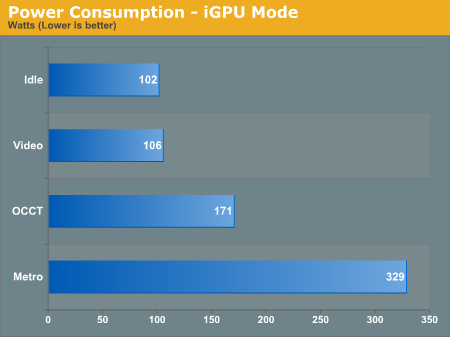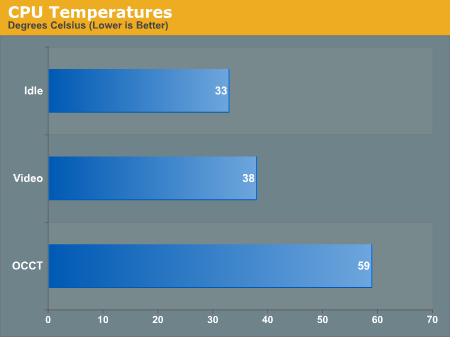ASUS P8P67 Review
by Brendan van Varik on September 8, 2011 10:45 AM EST- Posted in
- Asus
- Motherboards
- P67
Test Setup
| Processor |
Intel Core i5 2500K ES 4 cores, 4 threads, 6MB L3 |
| Motherboards | ASUS P8P67 |
| Cooling | Thermalright Ultra 120 eXtreme with one 120MM fan |
| Power Supply |
Silverstone 1000W Silver (Power Testing) OCZ ZX Series 1250w 80 PLUS Gold |
| Memory | Patriot Viper Extreme DDR3-2000MHz 9-11-9-27 2x4GB - 1.65v |
| Memory Settings | DDR3-1333MHz - 9-9-9-24 1T at 1.65v |
| Video Cards | Sapphire HD 5850 1GB |
| Video Drivers | Catalyst 10.12 |
| Hard Drive | Crucial C300 |
| Optical Drive | Samsung SH-S223Q |
| Case | Dimastech Bench Table |
| Operating System | Windows 7 64-bit |
| SATA Testing | Crucial C300 |
| USB 2/3 Testing | Patriot 64GB SuperSonic USB 3.0 |
Note - we will be moving to more recent drivers soon. We still use the 10.12 at the minute to keep parity between motherboard reviews, but this will be updated in the near future.
Comparison to Previous Results:
Power consumption was tested on the system as a whole with a wall meter connected to the power supply, while in a dual GPU configuration. This method allows us to compare the power management of the UEFI and the board to supply components with power under load, and includes typical PSU losses due to efficiency. These are the real world values that consumers may expect from a typical system (minus the monitor) using this motherboard.

CPU Temperatures
With most users running boards on purely default BIOS settings, we are running at default settings for the CPU temperature tests. This is, in our outward view, an indication of how well (or how adventurous) the vendor has their BIOS configured on automatic settings. With a certain number of vendors not making CPU voltage, turbo voltage or LLC options configurable to the end user, which would directly effect power consumption and CPU temperatures at various usage levels, we find the test appropriate for the majority of cases. This does confict somewhat with some vendors' methology of providing a list of 'suggested' settings for reviewers to use. But unless those settings being implemented automatically for the end user, all these settings do for us it attempt to skew the results, and thus provide an unbalanced 'out of the box' result list to the readers who will rely on those default settings to make a judgement.

The temperatures which I recorded are higher than motherboards from other manufacturers in a similar price bracket.










52 Comments
View All Comments
pc_void - Thursday, September 8, 2011 - link
I'm in the middle of rma with a different Asus board atm that has to be counted by [gasp] months.zero2dash - Thursday, September 8, 2011 - link
[shrugs]I bought mine despite all those NewEgg reviews and [H] negativity (although that's primarily towards the Pro) and I've had 0 problems with mine.
Very happily running @ 4.6 with 16GB of ram (ie all dimm slots populated). No problems whatsoever.
Pick a board, there's always a problem here or there, it doesn't matter who the manufacturer is.
re: Asrock - I had an Asrock X58 Extreme die after Folding@home 24/7 for 2 months; after RMA'ing it I bought a Gigabyte and sold the Asrock. First and last time I'll buy an Asrock board.
pc_void - Thursday, September 8, 2011 - link
Btw, Asrock boards are also made where Asus boards are made @ Foxconn - that says quite a lot right there.faizoff - Thursday, September 8, 2011 - link
I have the Pro version of this board which I got for around $140 on a very short and quick sale on Amazon. Having owned this board for more than 5 months now I'm really enjoying it's overclocking performance. At first the board wasn't stable and I guess I tried to do too many things before letting it settle in. I remember many sites, when SB came out, most of the ASUS versions. At the time of my build I initially bought a Gigabyte UD3 board which turned out to be a decent overclocker. I regretted at that time for not getting an Asus board that had glowing reviews and ridiculous overclocking stories.After the board recall, I took that opportunity to turn the Gigabyte board in and switch to an Asus one. I think something may have gone amiss with the B3 stepping version of many P67 boards. I first got the Deluxe version and had to RMA that. From the getgo it would crash and hang, just when going through BIOS options.
Getting this board at first also wasnt smooth sailing. After managing to find a stable mini OC at around 4.0 Ghz, I have now OC'd it to 4.5 while maintaining the same temperatures on Hyper 212+ cooling (mid 30s C at idle and mid 50s C on load) and core voltage at max of 1.384 V.
I'm very happy with the board at the moment 5 months on and hope that it continues this way. I certainly hope to keep this computer for another 4-5 years at least. I went from a system with 2.0 Ghz E4400, 1.5 GB DDR, 128 MB Radeon 9600 XT AGP 8x, 15" monitor @ 1024 x 768 that still works 4 years later.
Upgraded to
Intel i5 2500k OC 4.5 Ghz
G. Skills Ripjaw series 8 GB 1333Mhz DDR3 RAM
Asus P8P67 Pro
Crucial 64GB C300 SSD
XFX 6870 1 GB Radeon HD
Asus 23" monitor @ 1920x1080
Rosewill 630w Single +12 V rail
Corsair 600T case (In the process)
gramboh - Friday, September 9, 2011 - link
Man, that is a serious upgrade, I took pleasure reading your post thinking how awesome it must have been to power that new machine up for so long, must have been mind blowing how much faster it was, especially upgrading from a low res monitor to that, lol.Ratman6161 - Thursday, September 8, 2011 - link
Its pretty well known that increasing bclk doesn't work well with socket 1155. With my Asrock Z68 Pro 3 and 2600K, ANY increase in bclk makes the system unstable. Lucky I have those multipliers to play with.With your max overclock you say: "I was able to successfully boot up at 46x103 which gave me a final clock speed of 4738MHz. The system was nowhere near stable but it would get into Windows and run a few tests before crashing."
I bet if you had backed it off to 46x100 = 4600 you might have gotten it stable and the extra 138 Mhz are rather meaningless anyway. Just a thought.
cactusdog - Thursday, September 8, 2011 - link
I have to agree with the guy about the reviews on here lately... too many smartphone reviews and random stuff most of us arent interested in.jecs - Friday, September 9, 2011 - link
I have this MOBO since day 0 as it was almost the only ASUS option in CompuUSA back in January 8.I am using a 2600K with this and I've been very happy with the performance and stability. Basically 0 fails. Also 98% of the time this machine is isolated from the internet with very specific software and system updates.
Ok, I read about 2 previous reviews about this ASUS MOBO, but my point here is how good it is for 3D applications for the price and all you care is gaming. Great!, no complains just an observation.
Also I am using 2 graphic cards I don't care about the limit in the second card as in my case I am using an entry level Quadro 600 for pro 3D viewport applications and for the 8X I am using a 460 GTX 1GB for a few games and game engines. It works very well for me and also for a new rendering application still in beta called Octane. This is my exclusive 3D machine, but I knew very well what I was going to do with this motherboard.
jecs - Friday, September 9, 2011 - link
As many of you I don't like the direction the computer industry is taking with tablets and smartphones, but I understand for the massive market a desktop PC or even a laptop is not the best option. Ouch, I hope not to see a considerable increase in prices for desktop parts in the next years.I like to think of this as a happy time of coincidence when power users benefited from the growing consumer market needs. But that ship is not with us anymore.
just4U - Friday, September 9, 2011 - link
I don't really see the point of this board anymore. At $140 it's not really one of the cheaper boards out there.. and for 20-30 dollars less you can opt out for the better performing Z68. (Sure it might be MATX but even so) It doesn't really have a place in the current lineup unless they lower the price down enough to make it make it interesting.